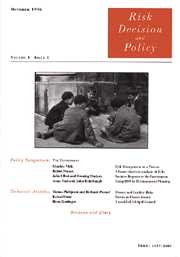No CrossRef data available.
Article contents
The effect of risk notification on mood in long-term survivors of Hodgkin's disease
Published online by Cambridge University Press: 02 January 2001
Abstract
Risk notification was the initial step in a larger study to determine (1) the prevalence of cardiovascular disease as a late effect of mediastinal irradiation, and (2) whether a brief support group intervention would mitigate any negative effects of risk notification.
323 HD survivors attended a 45 minute risk notification session prior to a routine follow-up medical visit. When they arrived at the clinic and following the risk notification session, they completed surveys that included measures of mood dysphoria, sense of coherence, knowledge of late effects of treatment, and demographic factors. Two analytic models were proposed to look at the effects of risk notification: (1) psychosocial state when arriving at the clinic, and (2) psychosocial change in state following risk notification session.
Pre-intervention mood distress was not significantly affected by time since the initial diagnosis, age, education, or gender. Person's who worked and those with better coping skills had lower initial mood distress. Knowledge of the late effects of treatment was not related to mood distress. Following the intervention, the more distressed a person was initially, the better the coping skills, the greater the decrease in mood distress. Partnered survivors experienced less of a decrease in distress. Knowledge of the late effects of treatment (regardless of their knowledge of cardiovascular disease as a consequence), did not effect change in mood distress.
Findings were contrary to expectations. Findings are consistent with Self-Regulation theory and the Health Belief Model and are not explained by anxiety related to the medical visit itself. Limitations of the study design are discussed.
The method through which risks are conveyed can reduce the psychosocial impact of risk notification.
- Type
- Technical article
- Information
- Copyright
- © 2000 Risk Decision and Policy




